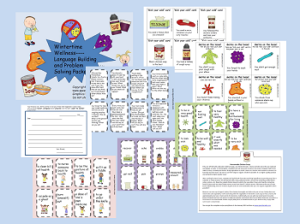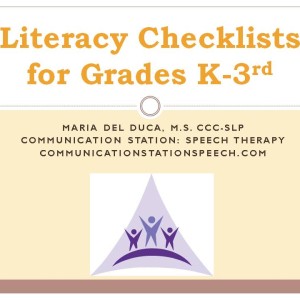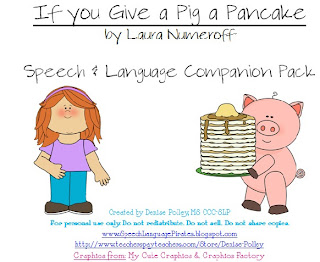 Today I am doing a product swap and giveaway with Rose Kesting of Speech Snacks. Rose runs a fun and unique blog. In her posts she combines her interest in nutrition and healthy cooking with her professional knowledge as a speech-language pathologist. I’ve collaborated with Rose in the past on a variety of projects and have always been impressed with the quality of her speech and language products, which are typically aimed at language remediation of older children (upper-elementary, middle school and high school ages). Continue reading Wintertime Wellness Product Swap and Giveaway
Today I am doing a product swap and giveaway with Rose Kesting of Speech Snacks. Rose runs a fun and unique blog. In her posts she combines her interest in nutrition and healthy cooking with her professional knowledge as a speech-language pathologist. I’ve collaborated with Rose in the past on a variety of projects and have always been impressed with the quality of her speech and language products, which are typically aimed at language remediation of older children (upper-elementary, middle school and high school ages). Continue reading Wintertime Wellness Product Swap and Giveaway
Category: Review
Birthday Extravaganza Day Twenty Eight: Literacy Checklists for Grades K-3

Today I am bringing you yet another giveaway from the fabulous Maria Del Duca of Communication Station Blog entitled: “Literacy Checklists for K-3rd Grade“. She created a terrific set of checklists to address reading comprehension and written expression in children K-3rd grade because according to Maria: “dynamic assessment of functional skills, when done well, can at times yield more accurate and salient information than standardized tests.”
This 10 page packet uses observational as well as teacher and parent reported information to present a holistic view of a child’s literacy skills with a focus on the following areas: Continue reading Birthday Extravaganza Day Twenty Eight: Literacy Checklists for Grades K-3
SLPs Blogging About Research: August Edition -FASD
 This month I am joining the ranks of bloggers who are blogging about research related to the field of speech pathology. Click here for more details.
This month I am joining the ranks of bloggers who are blogging about research related to the field of speech pathology. Click here for more details.
Today I will be reviewing a recently published article in The Journal of Neuroscience on the topic of brain development in children with Fetal Alcohol Spectrum Disorders (FASD), one of my areas of specialty in speech pathology.
Title: Longitudinal MRI Reveals Altered Trajectory of Brain Development during Childhood and Adolescence in Fetal Alcohol Spectrum Disorder
Purpose: Canadian researchers performed advanced MRI brain scans of 17 children with FASD between 5 and 15 years of age and compared them to the scans of 27 children without FASD. Each participant underwent 2-3 scans and each scan took place 2-4 years apart. The multiple scan component over a period of time is what made this research study so unique because no other FASD related study had done it before.
Aim of the study: To better understand how brain abnormalities evolve during key developmental periods of behavioral and cognitive progression via longitudinal examination of within-subject changes in white brain matter (Diffusion Tensor Imaging – DTI) ) in FASD during childhood and adolescence.
Subjects: Experimental subjects had a variety of FASD diagnoses which included fetal alcohol syndrome (FAS), partial FAS (pFAS), static encephalopathy alcohol exposed (SE:AE), neurobehavioral disorder alcohol exposed (NBD:AE), as well as alcohol related neurobehavioral disorder (ARND). Given the small study size the researchers combined all sub diagnoses into one FASD group for statistical analysis.
In addition to the imaging studies, FASD subjects underwent about ∼1.5 h of cognitive testing at each scan, administered by a trained research assistant. The test battery included:
- Woodcock Johnson Quantitative Concepts 18A&B (mathematics)
- Woodcock Reading Mastery Test-Revised (WRMT-R) Word ID
- Comprehensive Expressive and Receptive Vocabulary Test (CREVT)
- Working Memory Test Battery for Children (WMTB-C)
- Behavior Rating Inventory of Executive Function (BRIEF) parent form
- NEPSYI/II (auditory attention and response set; memory for names, narrative memory; arrows).
9/17 participants in the FASD group were also administered the Wide Range Intelligence Test (WRIT) at scan 2.
Control subjects were screened for psychiatric and neurological impairments. Their caregivers were also contacted retrospectively and asked to estimate in utero alcohol exposure for their child. Of the 21 control subject caregivers who were reached, 14/21 reported no exposure, 2/21 unknown, and 5/21 reported minimal alcohol exposure (range: 1–3 drinks; average of two drinks total during pregnancy). Control subjects did not undergo a full battery of cognitive testing, but were administered WRMT-R Word ID at each scan.
Summary of results: The FASD group performed significantly below the controls on most of the academic, cognitive, and executive function measures despite average IQ scores in 53% of the FASD sample. According to one of the coauthors, Sarah Treit, “longitudinal increases in raw cognitive scores (albeit without changes in age-corrected standard scores) suggest that the FASD group made cognitive gains at a typical rate with age, while still performing below average”. For those of us who work with this population these findings are very typical.
Imaging studies revealed that over time subjects in the control group presented with marked increases in brain volume and white matter – growth which was lacking in subjects with FASD. Furthermore, children with FASD who demonstrated the greatest changes in white matter development (on scans) also made the greatest reading gains. Children with the most severe FASD showed the greatest diffusion changes in white matter brain wiring and less overall brain volume.
Implications: “This study suggests alcohol-induced injury with FASD isn’t static – those with FASD have altered brain development, they aren’t developing at the same rate as those without the disorder.” So not only does the brain altering damage exists in children with FASD at birth, but it also continues to negatively affect brain development through childhood and at least through adolescence.
Given these findings, it is very important for SLPs to perform detailed and comprehensive language assessments and engage in targeted treatment planning for these children in order to provide them with specialized individualized services which are based on their rate of development.
Product Review: Interactive WH question Megabundle by Speech2u
 Today I am excited to review a cool WH question 97 page Mega Bundle by Kelly of Speech2u.
Today I am excited to review a cool WH question 97 page Mega Bundle by Kelly of Speech2u.
Kelly created this activity to help children with significant language impairments (e.g., ASD, intellectual disability, etc) answer who, what and where questions given fun visuals.
Her intent was to allow the SLPs to control the levels of difficulty by adjusting the # of choices or selecting similar choices to reduce the task complexity.
Bundle content:
48 WHERE cards
36 WHAT cards
126 QUESTION cards

Teaching slides/graphic organizers for each question type
Question sorting Mat
Game and Activity ideas for each set of cards
9 homework sheets with generalization questions
If using Sorting Mats Kelly recommends printing, laminating and cutting out PEOPLE, OBJECT and LOCATION cards. Then having the students sort the cards based on the type of question they need to answer. Some of her game recommendations include personalization: such as cutting out Logos from popular stores/restaurants from ads (ex. Walmart, Target) and asking questions like “Where do we go to get ______, or What is your favorite ______? etc. Other game suggestions include adding pictures of familiar buildings or places: favorite parks, museums, relatives houses and asking questions like: “Where did you go on ____?” Or “Where did ____ last week?”
I love how many activities games and suggestions Kelly offers in this bundle. In contrast to other ‘wh’ question sets available on the market from popular SLP vendor companies, hers just happens to be very visually appealing in terms of graphics, as well as offers a number of extra features for teaching concrete ‘wh’ questions. You can find this bundle in Kelly’s TPT store HERE or you can head over to her BLOG and enter to win a free copy in a Rafflecopter Giveaway!
Kelly is also currently reviewing my Speech Language Assessment of Older Internationally Adopted Children packet on her BLOG . So I will also be giving away a copy of it in a Rafflecopter Giveaway below.
SO DON’T FORGET TO READ BOTH REVIEWS AND ENTER BOTH GIVEAWAYS TO MAXIMIZE YOUR CHANCES TO WIN BOTH Prizes!
a Rafflecopter giveaway
App Review and Giveaway: Speech Therapy for Apraxia – NACD Home Speech Therapist
 Recently I got the opportunity to take a look at the “Speech Therapy for Apraxia – NACD Home Speech Therapist” by Blue Whale Apps.
Recently I got the opportunity to take a look at the “Speech Therapy for Apraxia – NACD Home Speech Therapist” by Blue Whale Apps.
According to the developer the app is applicable to
• SLPs with individuals with apraxia (both children and adults)
• Parents working with children with apraxia
• Traditional articulation practice (drills)
Developed by the National Association for Child Development (NACD) by an SLP, the Apraxia app provides choices of different phonemes to target and gradually increases the levels of difficulty to improve motor planning for speech. Continue reading App Review and Giveaway: Speech Therapy for Apraxia – NACD Home Speech Therapist
Gotta Love the RtI: Teacher Edition
 I have written about Response to Intervention (RTI) to intervention before (HERE), bemoaning the fact that it’s not currently utilized in my setting (outpatient specialized school in a psychiatric hospital) and how I was hoping to gradually incorporate it at work.
I have written about Response to Intervention (RTI) to intervention before (HERE), bemoaning the fact that it’s not currently utilized in my setting (outpatient specialized school in a psychiatric hospital) and how I was hoping to gradually incorporate it at work.
To summarize it briefly RtI is a 3 tiered approach to intervention that identifies children at risk for learning deficits and provides them with high quality instruction in order to separate the ones who just need a little extra help from children with true learning/language deficits. So you can tell that i am always on the looking for more RtI materials which is why I was very excited to come across Ms. Jocelyn’s RTI: Language, Listening & Speaking Packet. Continue reading Gotta Love the RtI: Teacher Edition
And now on the Importance of Context Clues!
I am a huge fan of teaching children context clues to navigate text. Context clues are hints of information that help us figure out the meaning of unfamiliar words. Context clues are the words and sentences that surround a word and help explain the word’s meaning. Context clues are hugely important because their comprehension and effective usage leads to academic success. They can increase the child’s vocabulary, reading comprehension, and make children better readers.
I am always looking for more materials to teach children how to interpret context clues which is why I was very excited when i got the opportunity to review Carrie’s of Carrie’s Speech Corner: “Out of This World! Context Clues“. This alien themed 21 page packet was created by Carrie to help students learn to use context clues by figuring out the meaning of nonsense words.
The premise is super cute and engaging. Student get to be the astronaut exploring a new planet who encounters aliens who speak a language similar to English, but with some very different words. So her first set entitled “Context Clues Multiple Choice Cards” has 20 stories in color (which are also repeated in black and white) which have nonsense-words from the “alien language.” Based on the context of the story students need to figure out the meaning of the alien word.

The second activity is called “Out of this World Dictionary” in which students get to create a dictionary using the alien words they’ve learned from the short stories. an answer key is provided of course.

The third activity involves matching English words to alien words by drawing a line, while the fourth activity is focused on making silly sentences with the alien words. There are two levels to this activity the first involving only one word while the second 2 words.
After that is “Category Sort” in which students fill in the allotted boxes with the alien words that best fit into the categories (such as sports, colors, school subjects, etc.)

Finally, the last activity is super fun. Students get to figure out their alien name by using a cipher.
I love the fact that this packet is heavily focused on problem solving and critical thinking skills because so many of our students can benefit from an extra dose of that. Depending on the students abilities and cognitive levels the packet might be applicable with a wide variety of age levels ranging from early elementary through middle school. You can find this packet in Carrie’s TPT Store HERE for a mere $2.50.
But that’s not all Carrie is doing a review of my Language Difference vs. Language Disorder Packet on her blog so we decided to do a giveaway of our respective products. She is doing a giveaway of my product I am doing a giveaway of hers, so enter my Rafflecopter giveaway below to win and don’t forget to head to Carrie’s Blog for an opportunity to maximize your chances to win both.
Focus on the common core
 Today I am reviewing two products by Lindsey Swanson-Karol of the Word Nerd Speech Teach Blog related to the core curriculum: the Common Core Based Language Assessment as well as her Robot Phonological Awareness Pack.
Today I am reviewing two products by Lindsey Swanson-Karol of the Word Nerd Speech Teach Blog related to the core curriculum: the Common Core Based Language Assessment as well as her Robot Phonological Awareness Pack.
Those of you who follow my blog know that when I select materials, I always try to make sure that the materials are multipurpose, multi-functional, and curriculum embedded.
First up is the Common Core Based Language Assessment. This 14 page informal language assessment is based on the common core for K-5 grade in the areas of the curriculum relevant to speech-language pathology. Continue reading Focus on the common core
Hurray for Book Companions: What will the pig want next?
 Is there anything more fun then literature based speech language intervention?
Is there anything more fun then literature based speech language intervention?
Rhetorical question of course, but seriously how much fun is it? Even the simplest books are jam-packed with a variety of language concepts, “wh” questions, target vocabulary, prepositions of location, and much, much more.
Of course, it’s always a bonus when I manage to create or obtain a book companion as a complement to the story, so the clients benefit the most from the activity. I also find book companions particularly useful when it comes to passing out the homework activities to the parents, many of whom require a little guidance regarding how to work at home with their children in order to increase carryover and ultimately reduce the child’s overall time in therapy. This is why I jumped at the opportunity to review one of Denise’s (Speech Language Pirates Blog) several book companions: “If you give a Pig a Pancake.” Continue reading Hurray for Book Companions: What will the pig want next?
It’s all about RtI!
 Today I am excited to review one of the latest products from Busy Bee Speech “Common Core Standards-Based RtI Packet for Language“.
Today I am excited to review one of the latest products from Busy Bee Speech “Common Core Standards-Based RtI Packet for Language“.
So what is RtI or Response to Intervention?
Developed as an alternative to the ability–achievement “discrepancy model,” which requires children to show a discrepancy between their IQ and standardized tests/grades, RtI is a method of academic intervention aimed to provide early, systematic assistance to children who are having difficulty learning in order to prevent academic failure via the provision of early school based intervention, frequent progress measurement, and increasingly intensive research-based instructional interventions for children who continue to have difficulty learning.
In contrast to a number of schools in my state (New Jersey), RTI or Response to Intervention is currently not utilized in my unique setting (outpatient specialized school in a psychiatric hospital). Continue reading It’s all about RtI!




